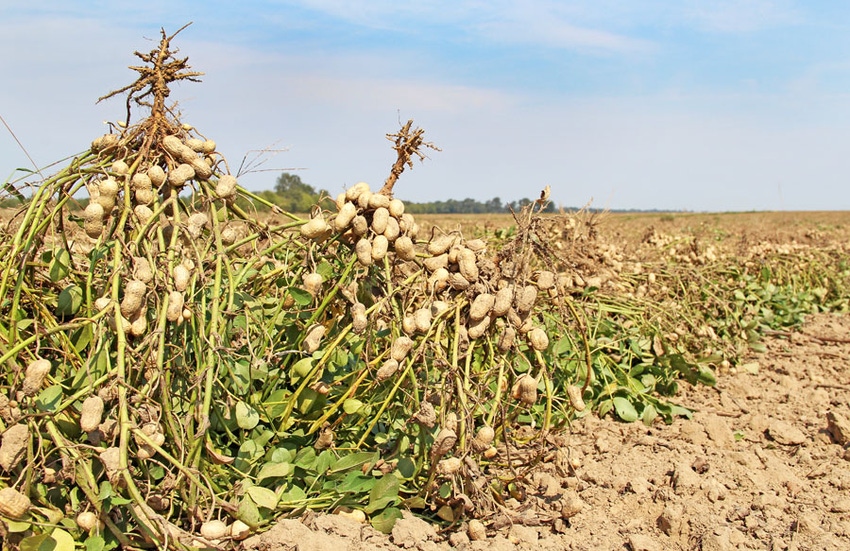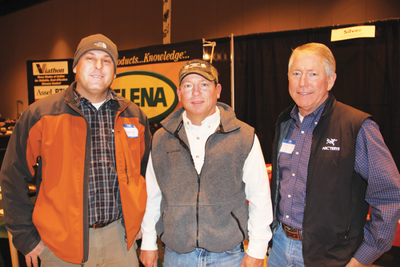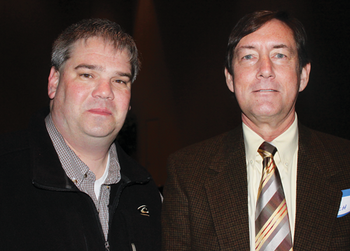
Producer decisions can mean profit or loss for peanuts
Decisions a producer makes can have a direct impact on the success of a peanut crop, says Scott Tubbs, associate professor and cropping systems agronomist at the University of Georgia/Tifton. "And those decisions can make money — or cost money."

While weather and markets are beyond the peanut grower’s control, there are factors for which decisions by the producer can have a direct impact on the success of the crop, says Scott Tubbs.
And those decisions can save money, or cost money, he said at the annual meeting of the Mississippi Peanut Growers Association,

JEREMY JOHNSON, from left, Tylertown, Miss.; Trey Bullock, Hattiesburg, Miss.; and David Short, Starkville, Miss., were among those attending the annual meeting of the Mississippi Peanut Growers Association.
“Early stand establishment is key to the entire peanut production scenario,” he says, “and seeding rate is probably the factor over which you have the most direct control. Other factors over which you have the ability to make choices include row pattern, soil pH, variety selection, fertility, tillage method, soil temperature and soil moisture at planting (via timing of planting the crop), and tractor speed when planting.”
Seed size will affect planting costs, notes Tubbs, who is associate professor and cropping systems agronomist at the University of Georgia/Tifton.
AG NEWS delivered daily to your inbox: Subscribe to Delta Farm Press Daily
“Large seeded varieties, such as Georgia-06G, Georgia-07W, Florida-07, and Tifguard, can average between 600 and 650 seed per pound, with 135 to 145 pounds needed per acre at the standard planting rate of 6 seed per foot of row, or 3 seed per foot of row in a twin-row pattern.
“Medium seed varieties can average 650 to 725 per pound, and small seed varieties, 725-plus per pound. So, depending on variety, there can be more than 25 pounds per acre difference in the amount of seed used.
“A few years ago, seed price went as high as $1.20 per pound, so there can be a $30 per acre difference in seed cost simply from variety selection. Similarly, changing the seeding rate by one seed per foot of row could alter seed cost by about $27 per acre using the same variety. So, increasing the seeding rate to boost plant stand could result in a reduction in net revenue if only a minor yield increase is realized.
“At an arbitrary contract price of $500 per ton, a 100-pound yield increase wouldn’t be enough to cover the cost of planting one additional seed per foot of row, and net revenue would be lower than if a lower seeding rate had been used.
Fine tune seeding rate
“In order to maximize profit, it is essential that you plant only the amount of seed that will give you an optimum plant stand and maximum yield potential.”
Seed prices have declined as seed supply has increased the last few years, Tubbs says, “but it’s still imperative that growers try and fine tune seeding rates to obtain optimum plant stands and maximize net revenue.
“Research over the past five years at multiple locations in Georgia — both single and twin rows, with various seeding rates and a wide selection of current varieties — showed a seeding rate of about 5 seed per row foot was adequate for maximum revenue potential in single row pattern.

GREG BOHACH, right, vice president of Agriculture, Forestry, and Veterinary Medicine at Mississippi State University, chats with Brian Atkins, Birdsong Peanuts, Prairie, Miss., at the MPGA meeting.
“But higher plant populations are needed in twin row pattern for maximum production, so increasing seeding rates to around 7 seed per row foot has been economical. More than 7 seed per foot of row often results in no yield benefit when plant populations go above optimum, and that ends up just being added expense for no realized benefit.”
Factors beyond the grower’s control, other than weather, Tubbs says, include soil borne and seed borne pathogens, seed quality and germination percentage of the seed, both of which are determined by growing conditions of the seed the previous year.
Tillage method is another practice for which the producer has a choice, he says, and there are pros and cons for each.
“Conventional tillage will bury more weed seed. If you have a weedy field, deep turning will bury a lot of the seed and make it difficult for them to come up. This can be one way of helping to control Palmer amaranth.
“It also will bury disease inoculum. We have research that shows deep tillage can reduce white mold more effectively than strip-till in heavy incidence situations. If you have serious white mold pressure, you can potentially get a benefit from deep tillage.”
Conventional tillage can increase herbicide efficacy in comparison to strip-till, Tubbs says. “Residues in strip-till fields can intercept some of the herbicides applied over the top, and if you aren’t irrigating you may lose some herbicide efficacy if you don’t get a rainfall shortly after application.
“Deep tillage will also warm the soil more rapidly, and soil temperature is big factor in getting a solid stand. It also provides a very good seedbed for seed-soil contact, and a friable environment for pegging and pod development. A raised bed also facilitates digging of peanuts better than a flat surface.”
Conventional tillage drawbacks
But there are drawbacks to conventional tillage, Tubbs notes.
“In hot weather, the soil may get too hot. On June 11, 2011, at one of our locations, we recorded a temperature of 116 F. at a 2-inch soil depth. Such high temperatures when the crop is setting flowers can cause pollen sterility that prevents fruiting, or scorch early pegs that are trying to enter the soil . You may not set a very good crop under such conditions.”
Conventional plowing can also create a compaction layer, with a hardpan in the soil profile that impedes deep root penetration, resulting in greater potential for runoff and/or loss of nutrients below the needed zone.
“Calcium is a mobile nutrient,” Tubbs says, “and in a year with a lot of rainfall there’s potential for it to be leached out of the pegging zone during heavy rainfall events, depriving developing pods of the calcium they need.”
In a strip-till system, he says, cover crops can reduce soil erosion and help build organic matter in soils that are deficient in organic matter.
“Strip-till will prevent the creation of hardpan layers, or if a hardpan is already there, it will help break it up. Residues can help to shade out weed escapes, reduce soil moisture evaporation, keep soil surface temperatures cooler, and retain more water after irrigation or rainfall.”
Strip-till can reduce the farmer’s equipment inventory, number of trips across the field, and total energy usage, Tubbs says. “In short, it saves soil, oil, and toil.”
Some drawbacks: The residues can intercept some of the herbicides applied and prevent them from reaching the target. “In addition, it’s difficult to plant twin rows in a strip-till scenario,” he says, “because the width of the disturbed strip is often only 7 or 8 inches, and if you’re trying to plant twin rows 7 to 8 inches apart, this can cause issues with residue interference.”
Residues may make pegging of peanut pods more difficult, or cause delays in development because the pegs have to travel farther to reach the soil surface when vines get hung up on cover crop residue, Tubbs says. “A flat surface and residue can also interfere with digging and inversion of peanuts.
“There’s really no right or wrong answer regarding use of conventional vs. strip-till for peanuts — it really depends on the situation and a balance of the positives vs. the negatives.”
About the Author(s)
You May Also Like



